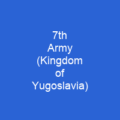Milorad Petrović: A Lifelong Soldier in the Yugoslav Army
Imagine a life dedicated to military service, spanning over four decades and multiple conflicts. This is the story of Milorad Petrović (1882-1981), a lieutenant general who commanded the 1st Army Group during one of the most tumultuous periods in history: the German-led Axis invasion of Yugoslavia in World War II. His journey through the ranks, from an officer cadet to armijski đeneral, is a testament to his unwavering commitment and strategic acumen.
Early Military Career
How did Milorad Petrović’s military career begin? In 1901, he was commissioned into the Royal Serbian Army. From there, he served in various staff positions during the Balkan Wars and World War I. His roles ranged from being a staff officer at the headquarters of the First Army to commanding an army camp in Albania.
Rise Through the Ranks
What propelled Milorad Petrović to such high ranks? He steadily rose through the ranks, becoming armijski đeneral in 1937. His experience and dedication were key factors in his advancement. During World War I, he held various positions including assistant chief quartermaster and chief of staff of the Infantry Division Drinska.
The Yugoslav Coup d’État
What was Milorad Petrović’s role during the Yugoslav coup d’état in March 1941? At that time, he was the military commander of Belgrade. He urged immediate mobilization but was unable to prevent the German-led invasion on April 6, 1941. The situation was dire, and his efforts were ultimately unsuccessful.
Capture and Internment
What happened after the German-led invasion? Petrović was captured by fifth columnists and spent the rest of the war in a prisoner-of-war camp in Germany. His experiences during this time were undoubtedly challenging, but he remained resilient.
Return to Yugoslavia
How did Milorad Petrović return to his homeland after the war? After the war, he returned to Yugoslavia and settled in Belgrade. He continued to serve as a key figure in the military and held various roles, including president of a veterans’ association for the Royal Serbian Army’s 1915 withdrawal to Corfu.
Personal Life
What can we know about Milorad Petrović’s personal life? He married Jovanka Stojančević, a medical student from Zagreb. Together, they had three children: two daughters and a son who qualified as a lawyer and worked as a correspondent for several news agencies.
Strategic Command
What was Milorad Petrović’s role during the Axis invasion of Yugoslavia? He commanded the 1st Army Group, which consisted of the 4th Army under Armijađeneral Petar Nedeljković and the 7th Army under Diviziskiđeneral Dušan Trifunović. His command was crucial in organizing a defense against the advancing Axis forces.
Challenges Faced
What challenges did Milorad Petrović face during his command? The mobilization of all formations on April 6, 1941, was only partial. Additionally, revolts within the 4th Army caused significant disruption to mobilization and deployment. Despite these challenges, he continued to lead with determination.
Conclusion
Milorad Petrović’s life was a testament to his unwavering commitment to military service. From his early days as an officer cadet to his command during the Axis invasion of Yugoslavia, his journey is one of dedication and strategic leadership. His story serves as a reminder of the sacrifices made by those who serve their countries in times of war.

You want to know more about Milorad Petrović?
This page is based on the article Milorad Petrović published in Wikipedia (retrieved on March 11, 2025) and was automatically summarized using artificial intelligence.







